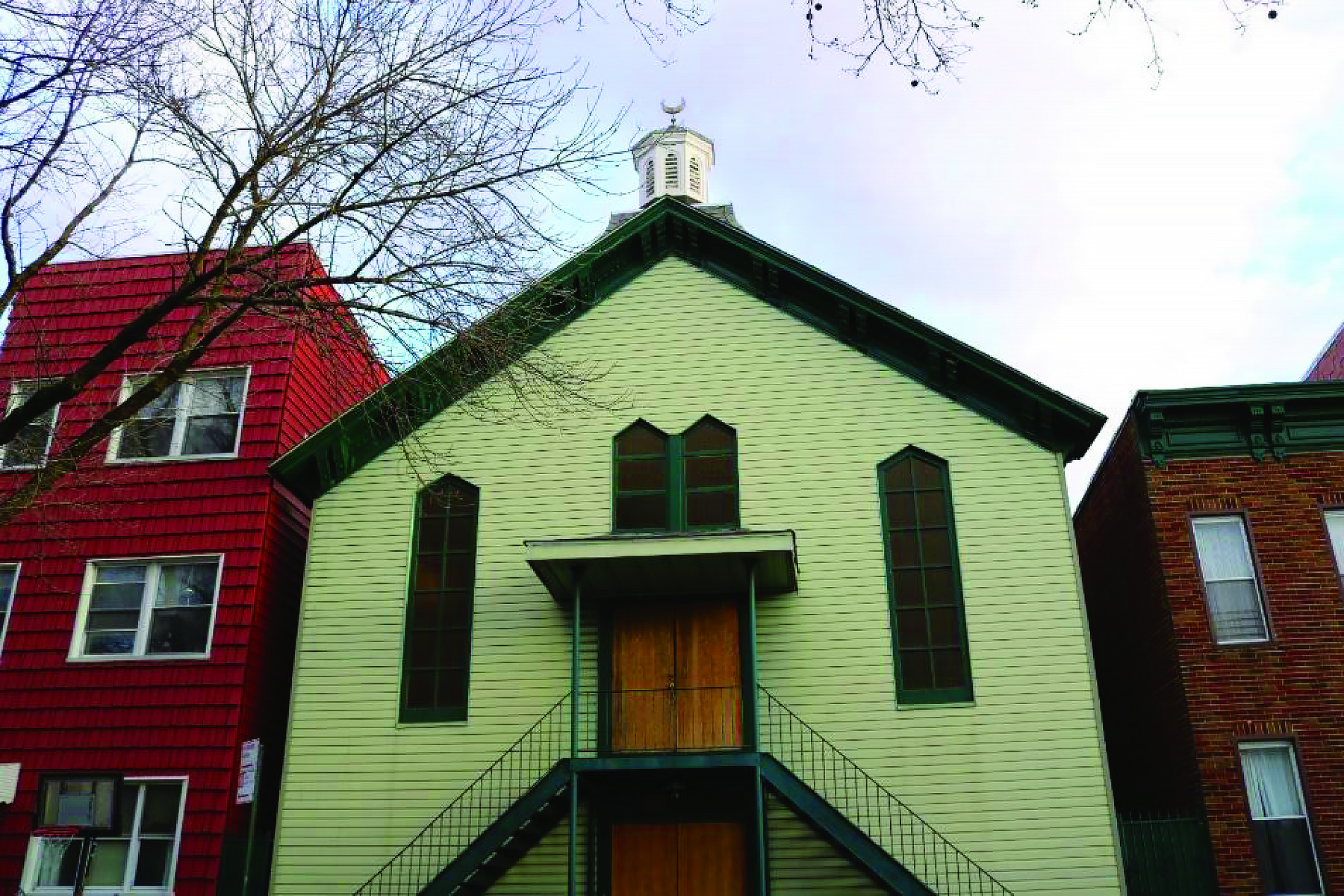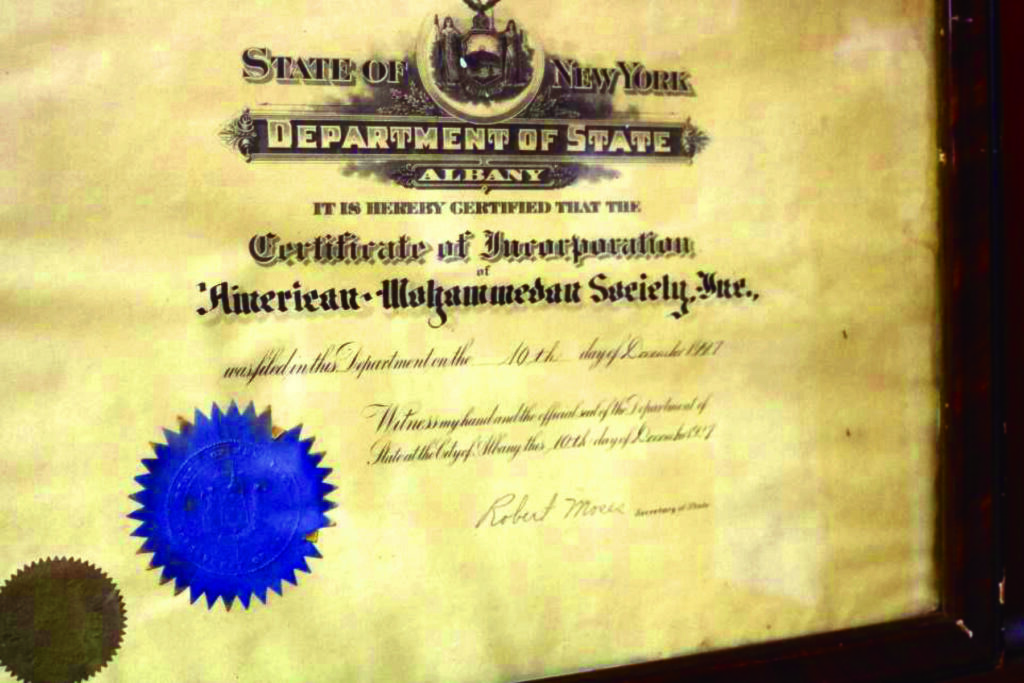“Moslem Mosque” Marks 117 Years
By Misbahuddin Mirza
July/Aug 2024

On a quiet residential street in New York City’s Riverside neighborhood of Williamsburg, Brooklyn, sits the “Moslem Mosque” — a quaint 117-year-old wood-framed structure in an increasingly affluent area.
In 1907, recently arrived Tatar Muslim immigrants formed the Lithuanian Tatar Society. In 1927, the name was changed to formally incorporate the American Mohammedan Society, Inc. (AMS).
In 1935, the community purchased the property on Powers Street from the Methodist Episcopal Church and added a crescent to its turret. The building’s existing wooden exterior matched the exterior of the Eastern European mosques they had left behind. All that was needed was to provide interior wood paneling to overcome the nostalgia of the Lithuanian mosques. This was promptly accomplished.
The AMS was formed by a group of Lithuanian (Lipka) Tatar Muslims who wanted a place to pray, socialize and impart a Quranic education to their younger generation.
Islamic Horizons spoke to the Brooklyn-born Marion Sedorowitz (BS, M Pharm., St. John’s University) and the Queens-born Alyssa Ratkewitch Haughwoot (MA, Pratt Institute, Brooklyn), the mosque’s treasurer and the vice president, respectively.
This formerly vibrant center, once teeming with energetic children learning to read the Quran, running around playing while grownups gathered to socialize and dine on ethnic delicacies and reflect on bettering their children’s future, is now a shadow of its former self. Unfortunately, the American melting pot has had a major impact on it. Sedorowitz blames inter-religious marriages as a key factor. A secondary reason is people moving away to find jobs elsewhere. Now this well-kept mosque, eerily quiet and desolate, is open only on those days announced on its Facebook page’s annual calendar and for members’ weddings and funerals.
Robert Shabanowitz, Ph. D., a lifetime member and current board member of the Brooklyn Mosque, opined that Lipka Tatars intermarried from their first arrival in Lithuania, often taking the names from their Lithuanian spouses. Shabanowitz had served as a laboratory director for in vitro fertilization, first at the University of North Carolina at Chapel Hill, and then at the Geisinger Medical Center in Danville, Penn. He believes that it was most likely the American acculturation of the succeeding generations that was primarily responsible for “the slow egress from the Society” (as it was referred to) occurred within the first generation of immigrants.

(Photo: Misbahuddin Mirza)
Prior to this, there was very limited loss due to intermarriage. “Both my parents were Moslem, as well as all my aunts and uncles and first cousins. Intermarriage was more a secondary consequence of this desire to become Americans. Another prevailing factor was the decline in importance of religiosity in the lives of second and third generation congregants. In the old country, the Jamia played a central role in the activities of these small communities such as Iwie in Belarus.
“Early on in our history of arrival to America, there was an immediate diaspora and settlement into other smaller Lipka Tatar communities and families in Pennsylvania, Massachusetts and Connecticut. Centrally located, was the American Lithuanian Society, the first incorporation of our Society in 1907. It is true that the majority of our congregation came to reside in the New York City area, mostly because this is where they could easily find work, such as the furrier business, an occupation known to them from Europe. Those settling outside the New York City area often found work in the coal mines or worked in were able to start farming.
“A major loss of congregants occurred as second and third generations became educated. Once again, religion as a binding cement became less important as children attended public school and college and eventually moved away from the city to find employment. In fact, a few first, and many second-generation members would celebrate well known Christian American holidays such as Easter and Christmas as simply secular holidays because they may have been the only Moslems in their public schools.”
Sedorowitz says she was the only Muslim in her school — Hauppauge High School — and that her school friends learned about Islam when she took the day off to celebrate Eid.
A Little History
New York City has come a long way. A recent Columbia University study showed that 10% of NYC school students are Muslims and that Eid is an official school holiday.
Sedorowitz also described the 1960s environment, a time when some neighbors had suddenly become concerned about the mosque, despite its decades’ long presence. Fortunately, the neighbors’ realized that their fears were misplaced, and normalcy soon returned.
Writing in the Dec. 26, 2018, edition of Bedford + Bowery, Zuha Siddiqui stated, “An article in a 1935 issue of The Muslim World Journal describes 104 Powers Street as a three-story wooden building that is the “only real mosque which exists today in America.”
Tharik Hussain, writing in the Oct. 23, 2017, issue of Arab News says, “The mass arrival of global immigrants at the turn of the 19th century led to several early Muslim communities being set up across America. Near Ross in North Dakota, a large rectangular, brick and wood building was used as a mosque by local Syrian and Lebanese immigrants in 1929. It was knocked down in the 1970s. Then, about twelve years ago, a tiny, brick ‘mosque’ with a dome and ornamental minarets was erected as a reminder of where it once stood. Another group of Syrian and Lebanese immigrants built the Rose of Fraternity Lodge — later called the Mother Mosque — in Cedar Rapids, Iowa, in 1934. It also fell into disrepair in the 1970s. But unlike the one in Ross, the Mother Mosque was rescued and renovated to serve as a heritage and education center.
The Tatars are Sunni Muslims from the historic, fabled Golden Horde Khanate of the Mongols who, after their conversion, protected fellow Arab and Turkic Muslims by fighting their unconverted Mongol kinspeople of the other khanates who were threatening to take revenge for their defeat at Ain Jalut (1260).
Fast forward to Amir Taimur (Tamerlane, 1336-1405) who defeated and chased out Khan Tokhtamysh of the Golden Horde. So, the Tatars moved to the Grand Duchy of Lithuania, ruled by Vytautas, where they eventually settled down and served as fierce warriors in service of Lithuania. The Tatars now live as minorities in Poland, Belarus and Lithuania.
Lithuania was politically an integral part of Poland from 1569 until the end of the 18th century, when the latter’s partitions placed it in the Russian Empire.
The Community Today
Agnieszka Pikulicka-Wilczewska, writing for Al Jazeera on Aug. 25, 2018, describes that despite 600 years of maintaining their identity, there is now a real fear that the Tatars will steadily lose their culture. “I would compare Polish Tatars to the Catholic Church in the West. It is a light version of Islam,” Tomasz Miskiewicz, mufti of Poland and chairman of Poland’s Muslim Religious Association, told Al Jazeera. “There are places where Friday prayers do not take place at all and places which are increasingly becoming history. It is a drift away from our identity.”
Inter-religious marriages are becoming common among the younger generation. “It used to be unthinkable. There were such situations, but it was a taboo,” says Dagmara Sulkiewicz, a Tatar religion teacher from Białystok. “Two weeks ago I was invited to a real Tatar wedding. But it is a relic.”
The New York–New Jersey–Connecticut tri state area is blessed with a very large Muslim population from diverse backgrounds who live in a harmonious mosaic. For example, while Astoria’s Bosnian Mosque and its Montenegrin Mosque have some exclusive traditional community events and get-togethers for linguistic reasons, five times a day they are full of Bangladeshi congregants.
A mosque comes to life due to the presence of its daily congregants. Maybe this Tatar Mosque should consider adopting the Bosnian and Montenegrin Muslims’ model for opening their beautiful landmark mosque for daily, or at least Friday, prayers. The arrival of the young Pakistani imam to lead tonight’s taraweeh prayer for a Zoom broadcast to other Tatars in the U.S. gives hope that New York’s Tatar Muslims might be open to pondering this vital idea.
Misbahuddin Mirza, M.S., P.E., is a licensed professional engineer, registered in the States of New York and New Jersey. He served as the regional quality control engineer for the New York State Department of Transportation’s New York City Region, authored the iBook “Illustrated Muslim Travel Guide to Jerusalem” and has written for major U.S. and Indian publications.
Tell us what you thought by joining our Facebook community. You can also send comments and story pitches to horizons@isna.net. Islamic Horizons does not publish unsolicited material.
